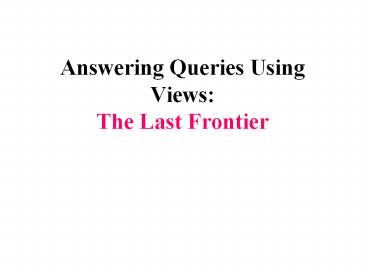Answering Queries Using Views: The Last Frontier - PowerPoint PPT Presentation
Title:
Answering Queries Using Views: The Last Frontier
Description:
Answering Queries Using Views: The Last Frontier The Problem Another Example Motivation Dimensions of the Problem View definition language Query language Semantic ... – PowerPoint PPT presentation
Number of Views:145
Avg rating:3.0/5.0
Title: Answering Queries Using Views: The Last Frontier
1
Answering Queries Using ViewsThe Last Frontier
2
The Problem
Given a query Q and a set of view definitions
V1,,Vn Is it possible to answer Q using only
the Vs? V1(A,B) - cites(A,B),
cites(B,A) V2(C,D) - sameTopic(C,D),
cites(C,C1), cites(D,D1) Query q(x,y) -
sameTopic(x,y), cites(x,y), cites(y,x) Query
rewriting q(X,Y) - V1(X,Y),
V2(X,Y) Unfolding of the rewriting
q(X,Y) - cites(X,Y), cites(Y,X),
sameTopic(X,Y), cites(X,Z), cites(Y,W)
3
Another Example
French cars data source DB1(name, year) -
ForSale(name, year, France, auto),
year gt 1990. Car review
database DB2(product, review) -
Review(product, review, auto) Query
q(X,Y,R)- ForSale(X,Y,C,auto),
Review(X,R,auto), Y gt
1985. Query plan q(X,Y,R) - DB1(X,Y),
DB2(X,R) Note rewriting is not equivalent to
the query, but we cant do any better.
4
Motivation
Query optimization
Physical data independence
Theory
Answering queries using views
Data warehouse design
Algorithms
Data integration
Commercial systems
Semantic data caching
Survey paper http//www.cs.washington.edu/homes/
alon/views-survey.ps
Web-site management
5
Dimensions of the Problem
- View definition language
- Query language
- Semantic constraints (e.g., FDs, inclusions)
- Completeness/soundness of the views
- Output query execution plan or logical plan.
- Equivalent or maximally contained rewriting.
6
Usability Conditions
Query q(X,Z) - r(X,Y), s(Y,Z), t(X,Z), Y gt
5. What can go wrong? V1(A,B) - r(A,C),
s(C1,B) (join predicate not applied) V2(A,B) -
r(A,C), s(C,B), C gt 1 (predicate too
weak). V3(A,B) - r(A,B), r1(A,B) (irrelevant
condition). V4(A) - r(A,B), s(B,C), t(A,C), B gt
5 needed argument is projected out. Can be
recovered if we have a functional dependency
t A --gt C. See Larson Yang, 87 and LMSS-95
for conditions.
7
Formal Definition Rewriting
Given a query Q and a set of view definitions
V1,,Vn Q is a rewriting of the query using Vs
if it refers only to the views or to interpreted
predicates. Q is an equivalent rewriting of Q
using the Vs if Q is equivalent to Q. Q is
a maximally-contained rewriting of Q w.r.t. L
using the Vs if there is no other Q such
that Q strictly contains Q, and Q is
contained in Q.
8
A Basic Decidability Result
- For conjunctive queries with no interpreted
predicates, the following holds - If Q has an equivalent rewriting using V, then
- there exists one with no more conjuncts than
Q. - Levy, Mendelzon, Sagiv Srivastava, PODS95
- The rewriting problem is NP-complete.
- Bound holds even if views have interpreted
predicates. - Maximally-contained rewriting union of all
conjunctive rewritings of the length of the query
or less.
9
Certain Answers
Given A query Q, View definitions
V1,Vn, Extensions of the views v1,vn.
Consider the set of databases D that are
consistent with V1,Vn and v1,vn. The tuple t
is a certain answer to Q if it would be an
answer in every database in D. Note an
equivalent rewriting provides all certain answers.
10
Finding All Answers from Views
If a rewriting is equivalent you definitely get
all answers Maximal containment only w.r.t. a
specific query language. So what is the
complexity of finding all the answers? Abiteboul
Duschka, PODS-98, Grahne and Mendelzon,
ICDT-99 surprisingly hard! Certain
answers Given specific extensions v1,vn to the
view, is the tuple t is an answer in every
database D that is consistent with the
extensions v1,,vn?
11
Why When is it Hard?
- Sources can be
- sound (open world assumption)
- complete
- sound and complete (closed-world assumption)
- If sources are either all sound or all complete,
then - maximally-contained rewriting exists.
- If the query contains interpreted predicates,
the - problem is NP-hard.
- If sources are sound and complete, the problem
is NP-complete.
12
Graph Colorability as Views
- V1(X) - edge(X,Y) (set of nodes in the graph)
- V2(Y) - color(X,Z) (the set red, green, blue)
- V3(X,Y)- edge(X,Y) (the set of edges).
- Query
- q(a) - edge(X,Y), color(X,Z), color(Y,Z)
13
Potpourri
- System-R optimization extensions Tsatalos et
al., VLDB94, Chaudhuri et al., ICDE-95. - VLDB-98 Oracles implemented algorithm.
- Infinite of views LRU, PODS-96, VP VLDB-97.
- Polynomial-time cases Chekuri Rajaraman,
ICDT-97. - Description logics Calvanese et al. 99.
- Inclusion dependencies Gryz, ICDE-97.
- Unions in views Afrati et al, ICDT-99, Duschas
thesis. - Semi-structured data VP, Sigmod-99.
14
Containment Queries over ViewsMillstein, Levy,
Friedman, PODS-2000
- Motivation equivalence of queries to data
integration systems. - Two different queries can be equivalent given a
specific set of sources. - Certain(Q1) Certain(Q2)?
- Pp2 for the conjunctive query case.
- Is decidable in some cases where the
maximally-contained rewriting is recursive.

